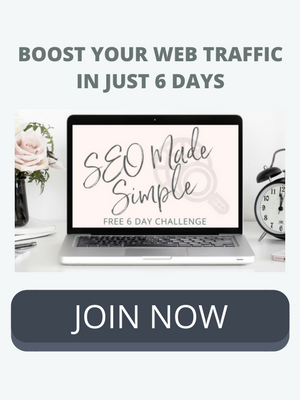4 Sustainable SEO Trends to Harness in 2020 & Beyond
/Google, Bing and other search engines are constantly analyzing what terms people are using, how relevant online content is and how people are using search. Each year significant updates are issued which make some marketers declare "SEO is dead!"
Which is silly...and missing the entire point of search engines.
The reality is search IS evolving, but many of the core SEO strategies continue to stand the test of time – I’ll share more of those in Part 3.
This post is part of a three-part series to help you improve your search rankings:
Part 1 | Simple issues with your branding & content which are easy-to-fix
Part 2 | Search is evolving, don’t get left behind!
Part 3 | Core SEO fundamentals you shouldn’t neglect
In Part 1, I shared the 1st reason your blog isn’t ranking and my top 8 (simple) tips to avoid rookie mistakes, develop your content strategy, improve brand awareness and increase your engagement – catch up here.
Today I want to help you understand the new search trends and how you can use them to help improve SEO.
It’s time to consider semantics and the future of how people search online.
Below, I’ll walk you through four main areas of future search and how you can tap into them to boost your web traffic and your search ranking.
Voice search is growing and millions of people now use Pinterest as a search engine – you need to get in on the action. I’ll also show you how you can use your (permanent &/or temporary) location to your advantage, and how to target the different stages of your customer’s journey.
Part 2 | Search is evolving, don’t get left behind!
This is the 2nd reason your blog isn’t ranking – discover the four big shifts below and how you make sure your business stands out.
A | You haven't considered the implications of voice search
Voice search is growing significantly.
People are using their smartphone apps, like Siri, Cortana or “OK Google” assistant more and more – Google voice search queries were 35x higher in 2016 compared with 2008 (Search Engine Watch).
But the way people use mobile voice search leans towards conversational phrases, questions, and long-tail keywords.
To figure out voice search phrases and use them, try this:
Imagine you’re the ideal client
Create a list of who, what, where, when, why, how (and how-to) questions
Speak into your smartphone and take a note of the longer questions you ask
Build value-rich content around those terms, the same way you would with other keywords.
Although voice search is gaining traction, don’t freak out when hearing claims like “50% of all searches will be voice searches by 2020”! (comScore)
Digital marketing agency Stone Temple surveyed 914 users and learned that people are less willing to use voice search in public, plus traditional searching methods still out-perform voice by more than 20%. And Seer found 66% of “OK Google” queries were “being spoken the same way they would be typed”.
What should you focus on?
Bring in voice search as a consideration when planning your keywords and content, but continue to invest in the core SEO fundamentals.
Voice search is a growing trend, but core SEO strategies continue to stand the test of time.
B | You need to start targeting the different stages of your customer journey
With through-the-roof mobile searching happening anytime + anywhere, and all options your clients experience online and there’s a multiverse of touch points and paths for your customers to take.
How, then, can you know where to meet them on their journey?
Google recommends you use the following four key micro-moments and target content to those.
I-Want-to-Know Moments
Your potential client is curious and looking for useful information or inspiration.
I-Want-to-Go Moments
Your potential customer is looking for a product, service or experience nearby (e.g. class, store, takeout, show).
I-Want-to-Do Moments
This is the “how to” and instruction realm – it can happen before &/or after a purchase.
I-Want-to-Buy Moments
They’re ready to buy – great! How can your content help them choose you?
Pairing intent with context helps you be there at the right time.
5 Examples of Targeting Customer Intent for SEO
1 | Spa owner – what are the top questions your customers have about collagen facials? How does this change when they’re at home after the kids are in bed, compared to having lunch with their best friends?
2 | Food blogger – what are the main things your ideal clients want to do with their evening meals? How does that change from a working/weeknight to a weekend?
3 | Life coach – what do your ideal clients want to know about achieving more confidence? How does this change from in an important meeting to going on a first date?
4 | Handbag designer – what are the top concerns your customers have when it comes to choosing a travel handbag? How will that change given a city break vacation vs a beach resort?
5 | PR agency – what are the main things your ideal client wants to do with their press campaign? How does this change when they’re preparing for a live TV interview compared to engaging with fans at an event?
While you start planning more specific content for the key micro-moments in your customers’ journeys, use your own mobile phone and put yourself in your client’s shoes to generate content ideas around the different types of search intent and context.
Don’t get left behind! Sign-up for my FREE 6-day challenge: SEO Made Simple!
Discover the REAL goal of your SEO – so more ideal clients find you online.
Free tools for keyword research & how to get the most out of them
How to write click-worthy headlines – for more click throughs & higher conversions.
Downloadable worksheets & cheat sheets
Short assignments so you’re taking real action
+ much more! - all yours, FREE!
C | You didn’t realize Pinterest is really a search engine
Pinterest is an extremely powerful tool for your business.
If I could only have one social media platform, I’d choose Pinterest. Why? It makes up 50%+ of my total website traffic and 85% of my social referral traffic.
But it wasn’t always that way.
At first, I used Pinterest sporadically and, at the end of 2014, I managed to double my blog traffic and increase my Pinterest referrals by 750%!
You can do this too.
Converting to a Pinterest Business account is the first step.
Realizing Pinterest is a visual search engine, which you can optimize for, is the second.
Not sure if Pinterest is worth your time? Check out these impressive statistics:
→ More than 2 billion searches take place on Pinterest each month
→ 150 million (& growing) active monthly users
Sources: Pinterest Business, Search Engine Journal, Search Engine Watch
→ 97% searches are unbranded
→ 76% of Pinners save items to purchase later
→ 72% of Pinners say Pinterest introduced them to a new brand
→ 55% use Pinterest to shop (this is higher than other search engines)
→ 42% use Pinterest to search instead of other search engines
Are you convinced yet?!
Once you decide to get strategic with your Pinterest account and start treating it less like social media and more like a powerful search engine, you’ll experience a significant impact on your business.
Ready to get involved? Start optimizing your blog posts and business for Pinterest.
D | You’re not using your location to your advantage
Search engines continue to customize results for their users, giving them more specific and locally-based results.
Google’s search AI RankBrain is learning and adapting at an 80% success rate, compared to the 70% of Google search engineers. This means that results for the same query will be different for users in the United States, for example, compared to users in the UK or Australia.
When I search “yoga studio Pittsburgh” the top 3 results below are highlighted on the map above the search results. This is referred to as the “local pack”, and it’s the coveted place.
When I use the term “location businesses”, I’m including:
Mobile or temporary location businesses, i.e. food trucks, mobile therapists, pop-up events, photographers, etc.
Bricks & mortar businesses, i.e. yoga studios, stores, spas, cafés, hotels, venues, theaters, offices, wellness centers, etc.
If you’re a location business, you should take full advantage of this opportunity!
So how do you do that?
5 Steps to Optimize Your Local Business for Search
Fill out your Google business profile (a good start on getting into the Local Pack)
Update business directories, like Yahoo!, Yelp, Local.com – get the top 50 directories on HubSpot
Are you a destination travelers would want to use (restaurant, hotel, spa, antique store… activity, attraction, event, tour etc.)? Make sure you’re on TripAdvisor
Encourage reviews (and make sure you respond)
Create content in support of other local businesses and events, as well as your own
So those are the big four areas of future search growth – phew!
Did you already have some of those covered?
What are you going to try now? Join me in the comments below.

























